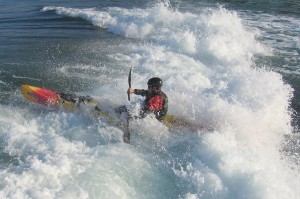Coaching paddlers when they are outside their comfort zone
Coaching Conference. Part 2. Workshop with Bob Timms
Skilful performance is achieved when you combine:
Technique
Tactical (when to do it)
Physical (capability to do it)
PsychologicaI
Ideas to consider when coaching kayakers in more advanced conditions.
Each paddler will have a different comfort zone which varies. The good coach needs to find out where this lies for each paddler (it can vary from day to day).
Build up trust with the paddler.
Take things step by step.
Build up in stages e.g. the rock hop, open sea roll -by adding bits of kit, changing water temperatures, etc.
Avoid information overload. The more outside the zone, the less information the coach should give.
Use of distraction- get them to sing so they are not over thinking the actions. Look out for rock hopping choristers around the coast and new BCU singing module.
Allow the paddler to decide when they are ready.
Reduce peer group pressure.
If it goes wrong and doesn’t work, step down a notch rather than retry the same event. Otherwise you may simply be reinforcing failure.
Look out for body cues which can impact on performance. E.g. when outside of our zone our paddle rate may change, we drop our chins and hunch shoulders. Both of which reduce mobility and restrict air intake.
Non verbal cues tell the coach a lot about what the paddler is thinking.

